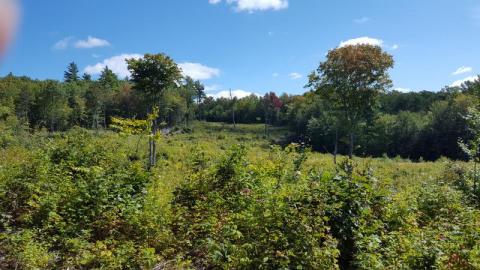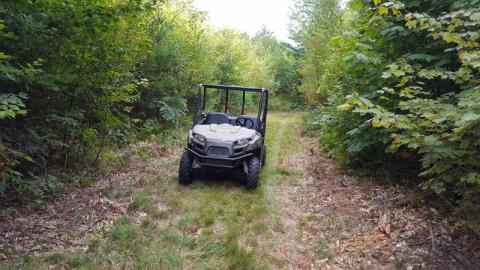A Managed Forest
Pierce Brook Forest, held mostly in a conservation easement, has been under the same management since 2000 when the property was purchased. Its total acreage is roughly 670 acres of forest, about 20% softwood and 80% mixed hardwood. Prior to current management, most of the forest had been high-graded, cutting the very best quality and leaving the rest to grow but never to overcome its quality limitations.
After a number of years considering alternatives, I decided that (1) the forest needed to be managed and (2) the forest would be managed by making periodic patch clear-cuts of roughly ten acres every 3 to 5 years. These patches would be scattered throughout the forest to create a checkerboard effect over years. This technique would lead to a very diverse forest in terms of age and structure. In the last eight years, nine patch clear-cuts have been made and two more are planned for 2019.

A patch cut on the property after two years of regrowth.
A patch cut on the property after two years of regrowth.
In following this plan my goals were three fold: first, I wanted to create a sustainable habitat for ruffed grouse, a great game bird which is indigenous to the area and which does not migrate. Second, I wanted to gradually improve the quality of timber by clear-cutting the patches which would be naturally restocked through reseeding and regrowth from existing stumps. Third, I wanted all of the expenses of the property to be paid for through profits from timber sales and federal wildlife grants, to the extent they were available.
Clear-cut lands take eight to ten years to regrow shrubs and saplings sufficiently to provide cover for ruffed grouse. So it has only been in the last year that we have seen a meaningful improvement in grouse population. Where aspen have been present, the cover has grown much faster.
At this point in our plan it seemed prudent to try to assess whether we were meeting the goals that we had set out.
With regard to the presence of ruffed grouse, Matt Tarr Ph.D., Extension Professor-Wildlife Specialist, at the UNH Cooperative Extension, an advisor on this property since 2000, laid out on our property map fourteen listening points for ruffed grouse drumming that would have easy access from established roads/trails, but points far enough apart to minimize the chance of hearing the same bird from more than one point.

A clearcut area on the Ernst property nine years after management.
Gary Speed, a hunting pal and accomplished outdoors man, volunteered to go to Matt’s listening points at least on a monthly basis and recorded what he saw and heard. His conclusion was that we had made a substantial improvement in ruffed grouse population and that in the spring and summer most of the birds were in or near the clear-cuts we had made in the previous eight years. He also found that in the winter the grouse were roosting in trees near the clear-cut, as we should have expected.
Gary also saw signs of a wide range of other animals including bobcats, moose, deer, and snowshoe hare while tracking grouse, which supports the idea that the diverse habitat we are creating is good for many other types of wildlife.
Needless to say, the plan is to continue making clear-cuts throughout the property. The financial goal are being met. Time will tell regarding the quality of the forest, but the sapling growth is vigorous.

